August 09, 2018 | Karen Warmkessel
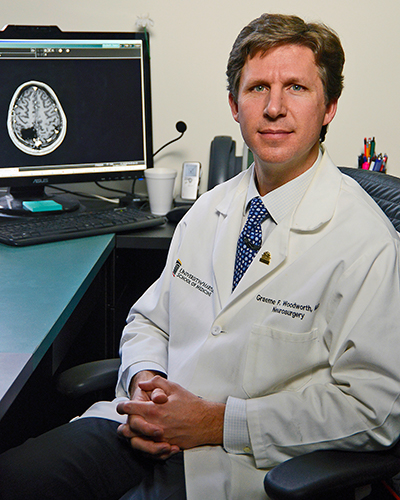
Brain’s Protective Network of Blood Vessels Impedes Cancer-Fighting Drugs from Reaching Tumors
In the first such clinical trial in the United States, physician-scientists with the University of Maryland School of Medicine (UMSOM) are investigating the use of MRI-guided focused ultrasound to open the blood-brain barrier. The trial will be conducted with patients undergoing brain cancer surgery at the University of Maryland Medical Center (UMMC).
The blood-brain barrier is a specialized network of vascular and brain cells that acts as the brain’s security system, helping to safeguard the brain and regulate the flow of substances into and out of it. While this network protects the brain, it also limits doctors’ ability to deliver effective doses of disease-fighting drugs to the brain, particularly in the case of brain tumors, which are notoriously treatment-resistant. This safety and feasibility study is a first step in attempting to overcome a major hurdle in treating these often-deadly cancers.
“The ability to temporarily disrupt the blood-brain barrier without causing tissue damage has the potential to dramatically alter the landscape of drug delivery to the brain for many diseases,” says the principal investigator, Graeme F. Woodworth, MD, professor of neurosurgery at UMSOM and director of the Brain Tumor Treatment and Research Center at the University of Maryland Marlene and Stewart Greenebaum Comprehensive Cancer Center (UMGCCC) at UMMC.
“If successful, this approach would allow us to use chemotherapy and other therapies in the brain in ways that are currently not possible,” says Dr. Woodworth, noting that 98 percent of currently approved drugs don’t enter the brain because of the blood-brain barrier. “If we can selectively open the blood-brain barrier, then in the future we could give a much lower dose of powerful drugs, which would likely reduce toxic side effects and make treatments safer and more effective for patients.”
The process involves injecting microscopic inert gas-filled bubbles into a patient’s bloodstream and then oscillating the microbubbles (causing them to move back and forth) with highly targeted sound waves, stretching the blood vessel walls to create temporary openings.
The U.S. Food and Drug Administration (FDA) approved the clinical trial in October 2017 after a lengthy review process. Although there are similar research studies in Canada and other countries, this was the first time the FDA approved a clinical study using this promising technology and approach.
Within a few months, University of Maryland researchers expect to open another FDA-approved clinical trial in which newly diagnosed glioblastoma patients will undergo blood-brain barrier opening prior to treatment with standard chemotherapy, temozolomide. This new ultrasound-augmented approach would target the areas where tumor recurrence would be most likely to occur.
Nearly 80,000 people are diagnosed with a primary brain tumor each year; 26,000 of these tumors are malignant. Glioblastoma is the most common type of brain cancer and the most deadly. Patients live an average of 15 months after diagnosis; the average five-year survival is only 5.5 percent.
“Glioblastoma is the most aggressive and lethal type of brain tumor, but treatment has been severely limited by our inability to get chemotherapy and other therapeutics through the blood-brain barrier,” says Kevin J. Cullen, MD, the Marlene and Stewart Greenebaum Distinguished Professor in Oncology at UMSOM and director of the UMGCCC. “Dr. Woodworth’s study is an important first step in finding an effective way to administer drug therapies that would improve patients’ quality of life and increase their survival.”
In the initial study, researchers plan to enroll up to 15 patients with suspected glioblastoma, an aggressive brain cancer, who will undergo surgery at UMMC to remove their tumor.
The morning of the scheduled surgery, patients will undergo a standard magnetic resonance imaging (MRI) scan as part of the preoperative planning process. Guided by this MRI, doctors will target a precise region within the tumor with ultrasound, while the injected microbubbles are circulating within the bloodstream. The microbubbles will oscillate within the ultrasound field, causing temporary openings in the walls of the brain blood vessels, and allowing the MRI contrast agent, gadolinium, to pass into the brain tissue. The MRI scan will then be completed, documenting the extent to which the blood-brain barrier was disrupted.
The data from the MRI will be used in a system called intraoperative stereotactic neuro-navigation – an advanced 3D-guidance system that accurately localizes the tumor within the brain. After the surgery, researchers will also rigorously examine the tissue that was removed to study the potential therapeutic and other effects from the focused ultrasound procedure.
In this initial trial, the increased amount of contrast enhancement within the tumor provided by the focused ultrasound procedure may help the 3D navigation during the surgery, according to Dr. Woodworth. “The standard of care is not changing in regard to the surgical procedure. We are functionally increasing the amount of navigation data available to the surgeon,” he says.
Dr. Woodworth notes that the disruption in the blood-brain barrier is not permanent, lasting about four to six hours.
The clinical trial is sponsored by InSightec, which has developed the MRI-guided focused ultrasound technology that will be used in the study. Neurosurgeons at UMMC are also using this technology to treat patients with neurological conditions, such as essential tremor and Parkinson’s disease, the latter as part of a clinical research study.
“MRI-guided focused ultrasound holds great promise in treating a variety of medical conditions, from cancer to Parkinson’s disease,” says UMSOM Dean E. Albert Reece, MD, PhD, MBA, who is also Executive Vice President for Medical Affairs at UM Baltimore, and the John Z. and Akiko K. Bowers Distinguished Professor and Dean, University of Maryland School of Medicine. “Our physician-scientists are leading major research studies and are at the forefront of efforts to determine how this new technology can be used to provide better treatments for patients.”
About the University of Maryland School of Medicine
Commemorating its 211th Anniversary, the University of Maryland School of Medicine was chartered in 1807 as the first public medical school in the United States. It continues today as one of the fastest growing, top-tier biomedical research enterprises in the world -- with 43 academic departments, centers, institutes, and programs; and a faculty of more than 3,000 physicians, scientists, and allied health professionals, including members of the National Academy of Medicine and the National Academy of Sciences, and a distinguished recipient of the Albert E. Lasker Award in Medical Research. With an operating budget of more than $1 billion, the School of Medicine works closely in partnership with the University of Maryland Medical Center and Medical System to provide research-intensive, academic and clinically-based care for more than 1.2 million patients each year. The School has over 2,500 students, residents, and fellows, and more than $520 million in extramural funding, with most of its academic departments highly ranked among all medical schools in the nation in research funding. As one of the seven professional schools that make up the University of Maryland Baltimore campus, the School of Medicine has a total workforce of nearly 7,000 individuals. The combined School and Medical System (“University of Maryland Medicine”) has an annual budget of nearly $6 billion and an economic impact in excess of $15 billion on the state and local community. The School of Medicine faculty, which ranks as the 8thhighest among public medical schools in research productivity, is an innovator in translational medicine, with 600 active patents and 24 start-up companies. The School works locally, nationally, and globally, with research and treatment facilities in 36 countries around the world. Visit medschool.umaryland.edu/
About the University of Maryland Marlene and Stewart Greenebaum Comprehensive Cancer Center
The University of Maryland Marlene and Stewart Greenebaum Comprehensive Cancer Center is a National Cancer Institute-designated Comprehensive Cancer Center in Baltimore. The center is a joint entity of the University of Maryland Medical Center and University of Maryland School of Medicine. It offers a multidisciplinary approach to treating all types of cancer and has an active cancer research program. It is ranked among the top cancer programs in the nation by U.S. News & World Report. www.umgccc.org.
Contact
Department of Anesthesiology
(410) 328-6120 (phone)
(410) 328-5531 (fax)
newsletter@som.umaryland.edu
University of Maryland Medical System/Medical Center
Media Relations Senior Manager
110 S. Paca Street., 9th floor
Baltimore, MD 21201
office: (410) 328-8919
mobile: (410) 404-1532
kwarmkessel@umm.edu
Related stories
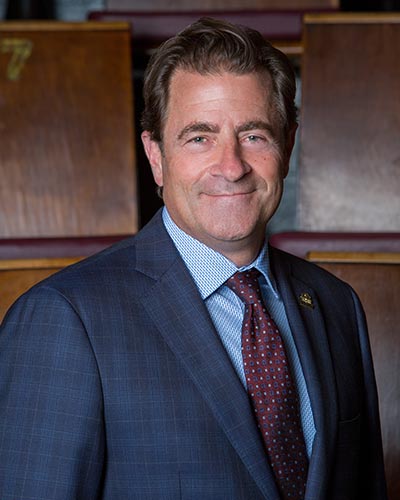
Monday, December 12, 2022
University of Maryland School of Medicine Launches New Maryland Institute for Neuroscience Discovery (UM-MIND)
University of Maryland School of Medicine (UMSOM) Dean Mark T. Gladwin, MD, has announced plans to launch a new neuroscience institute that will accelerate translational research of the brain by facilitating interaction between basic and clinical scientists and enhancing collaborative research across the UMSOM and University of Maryland, Baltimore (UMB) campus.
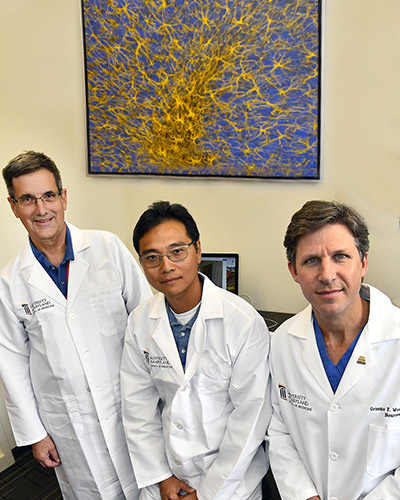
Wednesday, January 15, 2020
New Nanoparticle Therapy Appears More Effective Than Standard Therapy at Treating Aggressive Breast Cancer
Researchers at the University of Maryland School of Medicine (UMSOM) developed a new nanoparticle drug formulation that targets a specific receptor on cancer cells and appears to be more effective than a standard nanoparticle therapy currently on the market to treat metastatic breast cancer, according to a study published today in the journal Science Advances. The new ‘DART’ nanoparticles bypass healthy cells and tissues and bind to tumor cells, dispersing evenly throughout the tumor while releasing the chemotherapy drug paclitaxel.
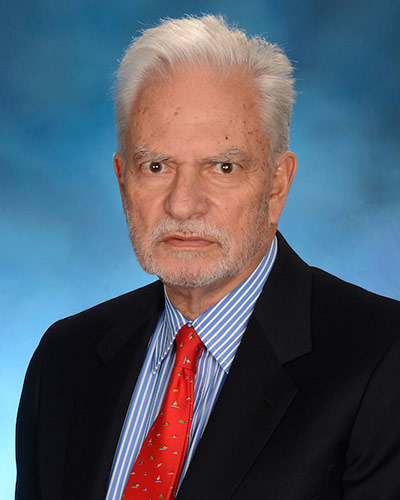
Thursday, March 28, 2019
UM School of Medicine Announces Leadership Transition in Department of Neurosurgery
Dean E Albert Reece, MD, PhD, MBA, announced today that longtime Chair of the Department of Neurosurgery and nationally-recognized neurosurgeon Howard M. Eisenberg, MD, will be stepping down at the end of this academic year as chair after 23 years. He will return to the full-time faculty of the UMSOM Department of Neurosurgery, retaining his title as the R.K. Thompson Professor of Neurosurgery. He will continue his research and his efforts advancing surgical techniques including gamma knife radiosurgery and image-guided focused ultrasound.
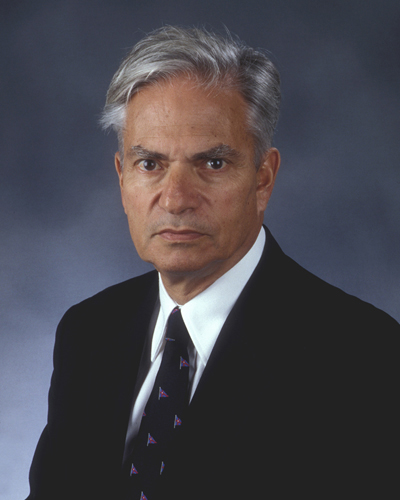
Friday, February 16, 2018
University of Maryland Medicine Leads Pivotal Study of Focused Ultrasound to Treat Parkinson's Disease
University of Maryland Medicine (the University of Maryland Medical Center (UMMC) and the University of Maryland School of Medicine (UMSOM)) is leading a phase 3 study to test the safety and efficacy of using MRI-guided focused ultrasound on the brain in order to treat Parkinson’s disease. The pivotal study is the final step before the U.S. Food and Drug Administration (FDA) will consider approving the new technology for widespread use as a nonsurgical treatment option to eliminate key motor symptoms of this common neurological condition.
